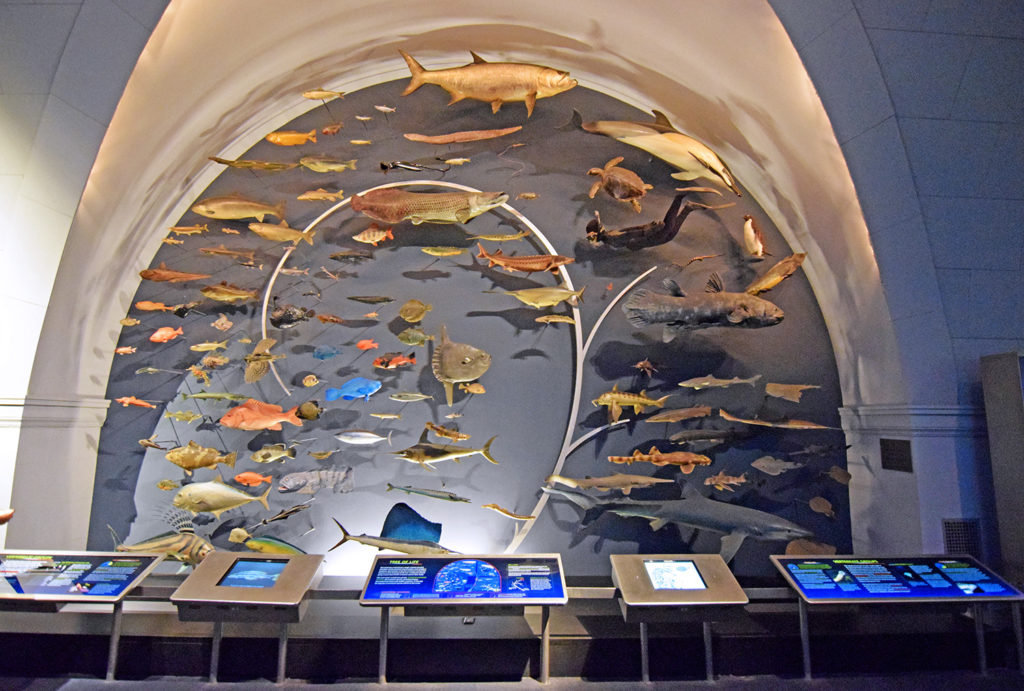
Animals Focus of this Course


Animals Objectives
-
Read a phylogenetic tree to determine the relatedness of different species.
-
List the basic characteristics of animals.
-
Describe the specific characteristics that distinguish Annelid worms from other animal species.

Trees are often used as icons, representing complex and connected concepts. Trees have been used for centuries to indicate the origins and relationships between species.
You can find this image on T-shirts, posters, and even as tattoos. Darwin sketched it into his notebook with the words “I think” after the voyage aboard H.M.S. Beagle.
The sketch is a version of the tree of life, in this section we’ll see why this visual metaphor is used and what it means.


This is a vertebrate (species with backbones) tree of life model in the American Museum of Natural History, New York City.
Many natural history museums have a version of the tree of life leading into their collection galleries.
This video introduces how tree diagrams are used in biology, and how we will use them in this course.
In the past structural characteristics like leg bones and feathers were used to place animals on branches of phylogenetic trees, now with new technologies, similarities and differences in genetic structure (DNA) are used as well. We’ll have more on the genetic analysis and phylogenetic tree of animals in an upcoming guide.
Does the structure of an evolutionary “phylogenetic” tree make sense to you?
If you feel you would like a bit more clarification on this tree model, we have another video on this guide’s extra resources page
An art installation in Singapore representing branches of phylogenetic trees.
Animals
What is an animal?
You have been learning about animals your entire life. Based on your experiences, write in your notes at least three characteristics that separate animals from other types of species.
Whenever there is a photo of paper ephemera from old books and magazines, like this picture, that is a visual cue to back up the verbal cue that you are accessing past experiences and knowledge.
How did you do?
The most common responses are: animals move, animals have many many cells, and animals eat other organisms.
General Animal Characteristics

Multicellular
All animals are built up of microscopic cells. In all animals, except the sponges, these cells are organized into tissues like muscle or nervous. (photo = muscle cells forming tissue, 400x)

Feeding
All animals consume other organisms, either living or dead. This food provides nutrients and energy necessary for cellular activity (photo = hand feeding deer).

Gas Exchange
Animals need oxygen to covert food into usable energy, and produce carbon dioxide as a waste product that needs to be eliminated. Respiratory systems move oxygen into the animal and carbon dioxide out. Cardiovascular systems move oxygenated blood around the body. (photo = lung model)

Sensory Systems
Most animals, except sponges, have nerves that receive sensory information. This information is necessary for movement and locating food. (photo = spinal cord model)

Movement
Animals move at some point in their lives, which is essential for finding food, mates, and territory. (photo = Anna’s Hummingbird, Calypte anna)
These characteristics are all correct for animals, BUT… other kinds of species can move (even bacteria); other species can have many cells (plants & fungi), and some fungi, plants, and microscopic species can consumer other organisms.
We need to more clearly define animals, and relate it to the ancestry we see in the phylogenetic trees.
Animals have groups of cells, called tissues, that enable flexible movement. We can see this flexible movement in action when we pinch our skin or in the undulations of this snail.

Most animals have significant differences in the size of the gametes or “sex cells:” the egg is typically much larger than the sperm, and there are often far more sperm. This impacts reproduction significantly in many animal species and we’ll see in the fitness guide.
Animals are commonly divided into the vertebrates (having a backbone, including humans) and invertebrates (not having a backbone).


The problem with thinking “verts. vs. inverts.” is that:
-
we all share a common ancestor, so there are many shared characteristics between the vertebrates and invertebrates.
-
it is easiest to put a lot of attention on us vertebrates, even though invertebrates play critical roles in Earth’s ecosystems.
-
there are far more invertebrate species on Earth.
Approximately 95% of the animal species on Earth are invertebrates
34 of the 35 animal phyla (largest classification groups) are invertebrates
Let’s take a closer look at one group of invertebrates: the Annelids
While watching this video, list the characteristics that clearly make these earthworms animals and list possible characteristics of earthworms (annelids) that set them apart from other animals.
Here are two other examples of annelids, what do they have in common with the earthworms?
Marine worm approximately two inches long that grab prey with tentacles.
Freshwater worms that eat decaying organic matter, approximately one inch long.
The animal kingdom is broken down into approximately 35 phyla. The number has changed as genetic analysis has led to discovery of new phyla.
Phylum Annelidia (the annelids) includes the earthworms, spaghetti worms, tubifex worms, and the amazing flower-like feather duster worm below. Its segmented body is protected by a paper-like tube it produces, its feeding and breathing gills are extending.

Charles Darwin’s final book, published about six months before his death, was a monograph about earthworms.
Cartoons from “Punch’s Almanack,” a periodical of Darwin’s time.

Darwin and his work were well known and well received by fellow scientists in his life time.

Darwin’s work impacts the way science discusses animals: that species share common ancestors, and have modified over time. In otherwords, humans and worms share a common ancestor, clearly with significant modifications.
In this course, you will be looking at shorter term inheritance, traits passed from parents to offspring and longer term evolutionary changes in species over time.
Phylogenetic trees are based on ancestry and genetic relatedness, and this is one way to think about animal species. Animals also play critical roles in food webs. The next section introduces another way to think about animal species; their function in the environment.

Check your knowledge. Can you:
-
read a phylogenetic tree to determine the relatedness of different species?
-
list the basic characteristics of animals?
-
describe the specific characteristics that distinguish Annelid worms from other animal species?



